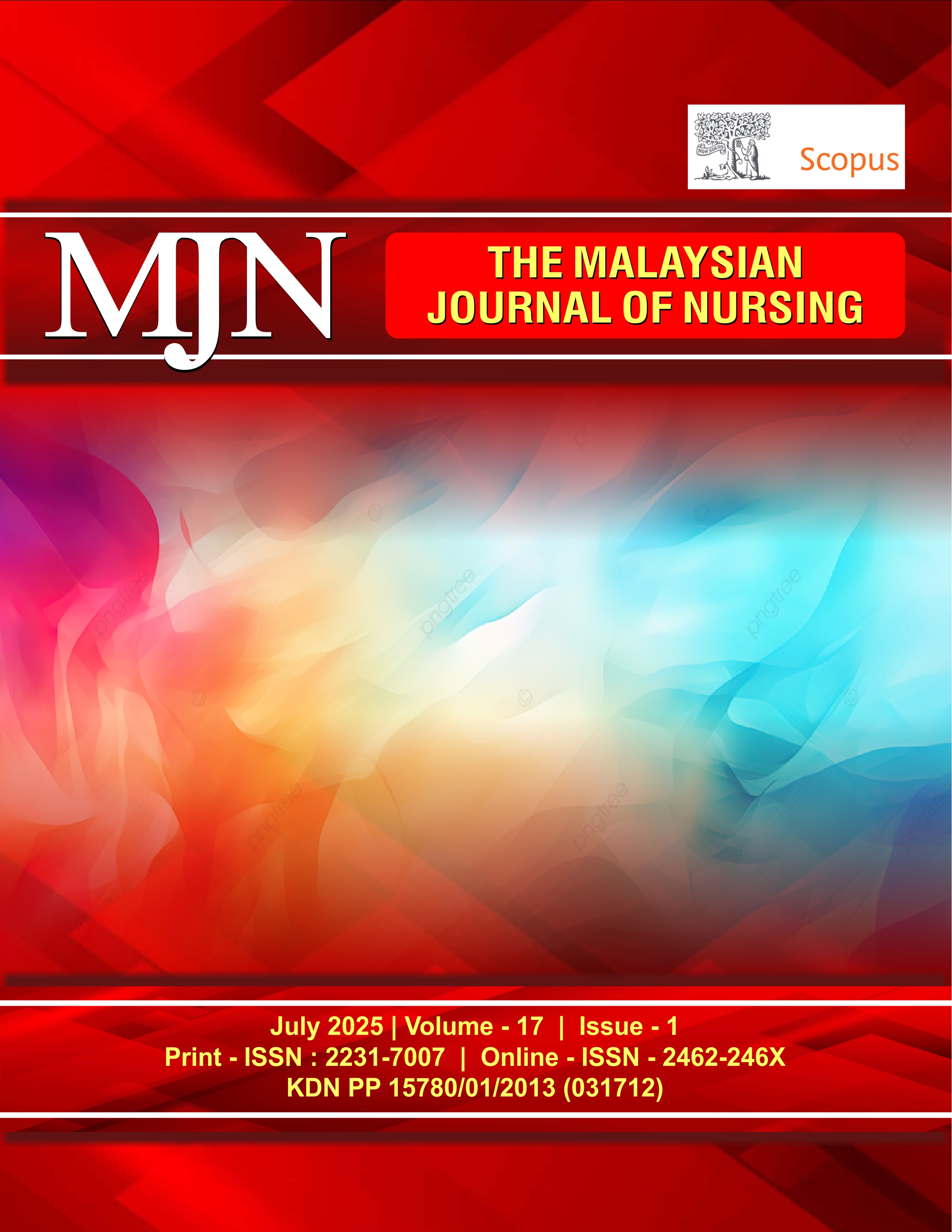Exploring the Impact of the SBAR on Nursing Handover: A Scoping Review
DOI:
https://doi.org/10.31674/mjn.2025.v17i01.024Abstract
Effective communication during nursing handovers is vital for ensuring patient safety and continuity of care. The SBAR (Situation, Background, Assessment, Recommendation) communication tool offers a structured framework that enhances clarity, efficiency, and reliability during shift transitions. This scoping review assesses the impact of SBAR on nursing handovers, with a focus on its effectiveness in improving communication, reducing errors, and enhancing patient safety. The review methodology guided by the PRISMA-ScR checklist, a systematic literature search was conducted across Medline, CINAHL, EMBASE, and EBSCO databases for the period January 2021 to June 2024. Thematic analysis of the identified studies indicates that SBAR significantly improves communication quality and patient safety, reduces handover-related errors, and promotes teamwork among nursing staff. Three studies reported notable reductions in errors, while two studies documented increased satisfaction among nurses and patients. Additionally, SBAR was associated with educational benefits, including improved knowledge and confidence in the handover process. The structured nature of SBAR contributes to a decrease in sentinel events linked to miscommunication and enhances nurses’ confidence and satisfaction with the handover process, thereby supporting teamwork and overall quality of care. Despite these positive outcomes, challenges remain in its implementation and integration across diverse healthcare settings. Further research is warranted to examine the long-term benefits of SBAR, compare its effectiveness with other communication tools, and optimise its application in varied clinical contexts. Addressing these areas will support SBAR’s continued role in improving nurse performance, patient safety, and healthcare quality.
Keywords:
Effectiveness, Handoffs, Handover, Nurses, SBARDownloads
References
Abdellatif, A., Bagian, J. P., Barajas, E. R., Cohen, M., Cousins, D., Denham, C. R., ... & Youngson, R. (2007). Communication during patient hand-overs: Patient safety solutions, volume 1, solution 3, May 2007. Joint Commission Journal on Quality and Patient Safety, 33(7), 439-442. Retrieved from: https://cdn.who.int/media/docs/default-source/integrated-health-services-(ihs)/psf/patient-safety-solutions/ps-solution3-communication-during-patient-handovers.pdf. Accessed on 28th August 2023.
Abdollahi, L., Jaberi, P., & Rokhafrooz, D. (2022). The effect of using SBAR model in shift handover on patient and nurse satisfaction in the emergency department. Journal of Health Administration 25(1). https://doi.org/10.52547/jha.25.1.24
Alizadeh-Risani, A., Mohammadkhah, F., Pourhabib, A., Fotokian, Z., & Khatooni, M. (2024). Comparison of the SBAR method and modified handover model on handover quality and nurse perception in the emergency department: a quasi-experimental study. BMC Nursing, 23(1). https://doi.org/10.1186/s12912-024-02266-4
Bakr, M., Elsaiad, H., & Rashed, S. (2023). Effectiveness of SBAR Daily Shift Report Training program on quality of care among staff nurses. Menoufia Nursing Journal, 8(3), 45-64. https://doi.org/10.21608/menj.2023.320812
Ballantyne, H. (2017). Undertaking effective handovers in the healthcare setting. Nursing Standard, 31(45), 53–62. https://doi.org/10.7748/ns.2017.e10598
Blom, L., Petersson, P., Hagell, P., & Westergren, A. (2015). The Situation, Background, Assessment and Recommendation (SBAR) model for communication between healthcare professionals: A clinical intervention pilot study. International Journal of Caring Sciences, 8(3), 530–535. Retrieved from: https://researchportal.hkr.se/ws/portalfiles/portal/40906913/FULLTEXT01.pdf. Accessed on 15th July 2023.
Callaway, C., Cunningham, C., Grover, S., Steele, K. R., McGlynn, A., & Sribanditmongkol, V. (2018). Patient handoff processes: Implementation and effects of bedside handoffs, the teach-back method, and discharge bundles on an inpatient oncology unit. Clinical Journal of Oncology Nursing, 22(4), 421–428. https://doi.org/10.1188/18.CJON.421-428
Coolen, E., Engbers, R., Draaisma, J., Heinen, M., & Fluit, C. (2020). The use of SBAR as a structured communication tool in the pediatric non-acute care setting: Bridge or barrier for interprofessional collaboration? Journal of Interprofessional Care, 1-10. https://doi.org/10.1080/13561820.2020.1816936
Daudt, H. M. L., van Mossel, C., & Scott, S. J. (2013). Enhancing the scoping study methodology: A large, inter-professional team's experience with Arksey and O'Malley's framework. BMC Medical Research Methodology, 13(48). https://doi.org/10.1186/1471-2288-13-48
De Meester, K., Verspuy, M., Monsieurs, K. G., & Van Bogaert, P. (2013). SBAR improves nurse-physician communication and reduces unexpected death: A pre and post intervention study. Resuscitation, 84(9). https://doi.org/10.1016/j.resuscitation.2013.03.016
Espinoza, K. E. (2016). Self-efficacy in situation background assessment and recommendation communication using information technology in baccalaureate nursing [Master's thesis, University of Nevada, Las Vegas]. Digital Scholarship@UNLV. https://digitalscholarship.unlv.edu
Ferrara, P., Terzoni, S., Davì, S., Bisesti, A., & Destrebecq, A. (2017). A tool for assessing the quality of nursing handovers: A validation study. British Journal of Nursing, 26(15), 882–888. https://doi.org/10.12968/bjon.2017.26.15.882
Frain, J. (2018). Why clinical communication matters: ABC of Clinical communication skills (pp. 98–105). Chichester: John Wiley & Sons, New Jersey, USA.
Ghosh, S., Ramamoorthy, L., & Pottakat, B. (2021). Impact of structured clinical handover protocol on communication and patient satisfaction. Journal of Patient Experience, 8. https://doi.org/10.1177/2374373521997733
Kostoff, M., Burkhardt, C., Winter, A., & Shrader, S. (2016). An interprofessional simulation using the SBAR communication tool. American Journal of Pharmaceutical Education, 80(9). https://doi.org/10.5688/ajpe809157
Levac, D., Colquhoun, H., & O'Brien, K. K. (2010). Scoping studies: Advancing the methodology. Implementation Science, 5(69). https://doi.org/10.1186/1748-5908-5-69
Manias, E., Geddes, F., Watson, B., Jones, D., & Della, P. (2015). Communication failures during clinical handovers lead to a poor patient outcome: Lessons from a case report. SAGE Open Medical Case Reports, 3. https://doi.org/10.1177/2050313X15584859
Martínez-Fernández, M. C., Castiñeiras-Martín, S., Liébana-Presa, C., Fernández-Martínez, E., Gomes, L., & Marques-Sanchez, P. (2022). SBAR method for improving well-being in the internal medicine unit: Quasi-experimental research. International Journal of Environmental Research and Public Health, 19(24). https://doi.org/10.3390/ijerph192416813
Merten, H., van Galen, L. S., & Wagner, C. (2017). Safe handover. BMJ. https://doi.org/10.1136/bmj.j4328.
Monti, M. C., Maiandi, S., Rossi, L., Villani, M., & Garofalo, C. (2022). Nurse Handover with SBAR method: a quasi-experimental study. Dissertation Nursing, 1(1), 3-11. https://doi.org/10.54103/dn/17691
Müller, M., Jürgens, J., Redaèlli, M., Klingberg, K., Hautz, W. E., & Stock, S. (2018). Impact of the communication and patient hand-off tool SBAR on patient safety: A systematic review. BMJ Open, 8(8). https://doi.org/10.1136/bmjopen-2018-022202
Murray, M. (2016). Implementing SBAR Training with Acute Care Nurses. DNP Projects, 90, 1-82. Retrieved from: https://uknowledge.uky.edu/dnp_etds/90. Accessed on 17th November 2023.
NHS Institute for Innovation and Improvement. (2010). The handbook of quality and service improvement tools. Retrieved from: https://tinyurl.com/ycz9mwgj. Accessed on 15th November 2023.
Nursing and Midwifery Council. (2018). The code: Professional standards of practice and behaviour for nurses, midwives and nursing associates. Retrieved from: https://tinyurl.com/gozgmtm. Accessed on 24th August 2023.
Park, L. J. (2020). Using the SBAR handover tool. British Journal of Nursing, 29(14). https://doi.org/10.12968/bjon.2020.29.14.812
Park, L., Allan, J., & Hill, B. (2019). Data gathering and patient monitoring. In I. Peate, Fundamentals of Nursing (pp. 45–67). Elsevier, Edinburgh, UK.
Patient Safety Movement Foundation (2022). Hand-off communication APSS. Retrieved from: https://psmf.org/wp-content/uploads/hand-off-communication.pdf. Accessed on 19th November 2023.
Pazar, B., Kavakli, O., Ak, E. N., & Erten, E. E. (2024). Implementation and evaluation of the SBAR communication model in nursing handover by pediatric surgery nurses. Journal of PeriAnesthesia Nursing, 39(5), 847–852. https://doi.org/10.1016/j.jopan.2023.12.021
Pollock, D., Peters, M. D. J., Khalil, H., McInerney, P., Alexander, L., Tricco, A. C., et al. (2023). Recommendations for the extraction, analysis, and presentation of results in scoping reviews. JBI Evidence Synthesis, 21(3), 520–532. https://doi.org/10.11124/JBIES-22-00123
Pope, B. B., Rodzen, L., & Spross, G. (2008). Raising the SBAR: How better communication improves patient outcomes. Nursing, 38(3), 41–43. https://doi.org/10.1097/01.NURSE.0000312625.74434.e8
Pucher, P. H., Johnston, M. J., Aggarwal, R., Arora, S., & Darzi, A. (2015). Effectiveness of interventions to improve patient handover in surgery: A systematic review. Surgery, 158(1), 85–95. https://doi.org/10.1016/j.surg.2015.02.017
Randmaa, M., Mårtensson, G., Leo Swenne, C., & Engström, M. (2014). SBAR improves communication and safety climate and decreases incident reports due to communication errors in an anaesthetic clinic: A prospective intervention study. BMJ Open, 4(1). https://doi.org/10.1136/bmjopen-2013-004268
Royal College of Nursing. (2019). Communication and empathy. Retrieved from: https://www.rcn.org.uk/centenary/Projects/100-top-tips/Communication-and-empathy. Accessed on 27th November 2023.
Ruhomauly, Z., Betts, K., Jayne-Coupe, K., Karanfilian, L., Szekely, M., Relwani, A., McCay, J., & Jaffry, Z. (2019). Improving the quality of handover: Implementing SBAR. Future Healthcare Journal, 6(Supplement 2). https://doi.org/10.7861/futurehealth.6-2-s54
Sembiring, M. C., Nasution, S. L. R., & Girsang, E. (2022). The Effect of Sbar Communication On Nurse Attitude in Increasing Patient Safety in Krmt Wongsonegoro Hospital, Semarang. International Journal of Health and Pharmaceutical (IJHP), 2(4), 680-683. https://doi.org/10.51601/ijhp.v2i4.91
Shahid, S., & Thomas, S. (2018). Situation, background, assessment, recommendation (SBAR) communication tool for handoff in health care–A narrative review. Safety in Health, 4(1), 1-9. https://doi.org/10.1186/s40886-018-0073-1
Shinta, N. D., & Bunga, A. L. (2024). The implementation of SBAR communication method for patient safety: A literature review. Malahayati International Journal of Nursing and Health Science, 7(5), 537-553. https://doi.org/10.33024/minh.v7i5.190
Starmer, A. J., Spector, N. D., Srivastava, R., West, D. C., Rosenbluth, G., Allen, A. D., ... & Landrigan, C. P.; I PASS Study Group. (2014). Changes in medical errors after implementation of a handoff program. The New England Journal of Medicine, 371(19), 1803–1812. https://doi.org/10.1056/NEJMsa1405556
Stewart, K. R. (2016). SBAR, communication, and patient safety: An integrated literature review. Retrieved from: https://scholar.utc.edu/cgi/viewcontent.cgi?article=1070&context=honors-theses&httpsredir=1&referer=. Accessed on 11th October 2023.
Toumi, D., Dhouib, W., Zouari, I., Ghadhab, I., Gara, M., & Zoukar, O. (2024). The SBAR tool for communication and patient safety in gynaecology and obstetrics: A Tunisian pilot study. BMC Medical Education, 24(1). https://doi.org/10.1186/s12909-024-05210-x
Tricco, A. C., Lillie, E., Zarin, W., O’Brien, K. K., Colquhoun, H., Levac, D., et al. (2018). PRISMA extension for scoping reviews (PRISMA-ScR): Checklist and explanation. Annals of Internal Medicine, 169(7), 467–473. https://doi.org/10.7326/M18-0850
Yun, J., Lee, Y. J., Kang, K., & Park, J. (2023). Effectiveness of SBAR-based simulation programs for nursing students: A systematic review. BMC Medical Education, 23(1). https://doi.org/10.1186/s12909-023-04495-8
Zou, X. J., & Zhang, Y. P. (2016). Rates of nursing errors and handoffs-related errors in a medical unit following implementation of a standardized nursing handoff form. Journal of Nursing Care Quality, 31(1), 61–67. https://doi.org/10.1097/NCQ.0000000000000133
Published
How to Cite
Issue
Section
License
Copyright (c) 2025 The Malaysian Journal of Nursing (MJN)

This work is licensed under a Creative Commons Attribution-NonCommercial-NoDerivatives 4.0 International License.



































